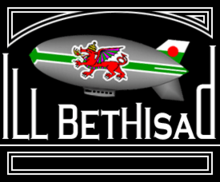Most languages of Europe belong to the Indo-European language family. Out of a total European population of 744 million as of 2018, some 94% are native speakers of an Indo-European language. Within Indo-European, the three largest phyla in Europe are Romance, Germanic, and Slavic; they have more than 200 million speakers each and together account for close to 90% of Europeans. Smaller phyla of Indo-European found in Europe include Hellenic, Baltic, Albanian, Celtic, and Armenian ; Indo-Aryan, though a large subfamily of Indo-European, has a relatively small number of speakers in Europe.

Fictional languages are the subset of constructed languages (conlangs) that have been created as part of a fictional setting. Typically they are the creation of one individual, while natural languages evolve out of a particular culture or people group, and other conlangs may have group involvement. Fictional languages are also distinct from natural languages in that they have no native speakers. By contrast, the constructed language of Esperanto now has native speakers.

The Slavic languages, also known as the Slavonic languages, are Indo-European languages spoken primarily by the Slavic peoples and their descendants. They are thought to descend from a proto-language called Proto-Slavic, spoken during the Early Middle Ages, which in turn is thought to have descended from the earlier Proto-Balto-Slavic language, linking the Slavic languages to the Baltic languages in a Balto-Slavic group within the Indo-European family.

Ukrainian is an East Slavic language of the Indo-European language family, spoken primarily in Ukraine. It is the native language of Ukrainians.
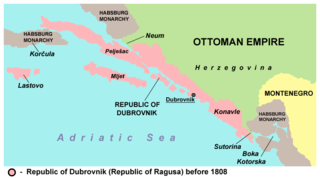
Dalmatian or Dalmatic was a Romance language that was spoken in the Dalmatia region of present-day Croatia, and as far south as Kotor in Montenegro. The name refers to a tribe of the Illyrian linguistic group, Dalmatae. The Ragusan dialect of Dalmatian, the most studied prestige dialect, was the official language of the Republic of Ragusa for much of its medieval history until it was gradually supplanted by other local languages.
The Istriot language is a Romance language of the Italo-Dalmatian branch spoken by about 400 people in the southwestern part of the Istrian peninsula in Croatia, particularly in Rovinj and Vodnjan. It should not be confused with the Istrian dialect of the Venetian language or the more distantly related Eastern Romance Istro-Romanian.
Venedic is a naturalistic constructed language, created by the Dutch translator Jan van Steenbergen. It is used in the fictional Republic of the Two Crowns, based on the Polish–Lithuanian Commonwealth, in the alternate timeline of Ill Bethisad. Officially, Venedic is a descendant of Vulgar Latin with a strong Slavic admixture, based on the premise that the Roman Empire incorporated the ancestors of the Poles in their territory. Less officially, it tries to show what Polish would have looked like if it had been a Romance instead of a Slavic language. On the Internet, it is well-recognized as an example of the altlang genre, much like Brithenig and Breathanach.
A constructed writing system is a writing system specifically created by an individual or group, rather than having evolved as part of a language or culture like a natural script. Some are designed for use with constructed languages, although several of them are used in linguistic experimentation or for other more practical ends in existing languages. Prominent examples of constructed scripts include Korean Hangul and the International Phonetic Alphabet.
Brithenig, or also known as Comroig, is an invented language, or constructed language ("conlang"). It was created as a hobby in 1996 by Andrew Smith from New Zealand, who also invented the alternate history of Ill Bethisad to "explain" it. Officially according to the Ill Bethisad Wiki, Brithenig is classified as a Britanno-Romance language, along with other Romance languages that displaced Celtic.
An artistic language, or artlang, is a constructed language designed for aesthetic and phonetic pleasure. Language can be artistic to the extent that artists use it as a source of creativity in art, poetry, calligraphy or as a metaphor to address themes such as cultural diversity and the vulnerability of the individual in a globalizing world.

In linguistics, mutual intelligibility is a relationship between languages or dialects in which speakers of different but related varieties can readily understand each other without prior familiarity or special effort. It is used as an important criterion for distinguishing languages from dialects, although sociolinguistic factors are often also used.
The History of Dalmatia concerns the history of the area that covers eastern coast of the Adriatic Sea and its inland regions, from the 2nd century BC up to the present day.
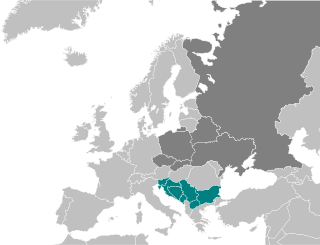
South Slavs are Slavic peoples who speak South Slavic languages and inhabit a contiguous region of Southeast Europe comprising the eastern Alps and the Balkan Peninsula. Geographically separated from the West Slavs and East Slavs by Austria, Hungary, Romania, and the Black Sea, the South Slavs today include Bosniaks, Bulgarians, Croats, Macedonians, Montenegrins, Serbs, and Slovenes, respectively the main populations of Bosnia and Herzegovina, Bulgaria, Croatia, North Macedonia, Montenegro, Serbia, and Slovenia.
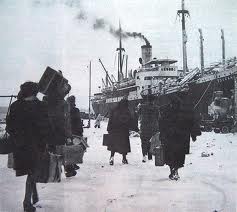
The Italian language is an official minority language in Croatia, with many schools and public announcements published in both languages. Croatia's proximity and cultural connections to Italy have led to a relatively large presence of Italians in Croatia. Italians were recognized as a state minority in the Croatian Constitution in two sections: Istrian Italians and Dalmatian Italians. Although only 0.43% of the total population is Italian by citizenship, many more are ethnically Italian and a large percentage of Croatians speak Italian, in addition to Croatian.

A constructed language is a language whose phonology, grammar, and vocabulary, instead of having developed naturally, are consciously devised for some purpose, which may include being devised for a work of fiction. A constructed language may also be referred to as an artificial, planned or invented language, or a fictional language. Planned languages are languages that have been purposefully designed; they are the result of deliberate, controlling intervention and are thus of a form of language planning.

Croatian is the standardized variety of the Serbo-Croatian pluricentric language mainly used by Croats. It is the national official language and literary standard of Croatia, one of official languages of Bosnia and Herzegovina, Montenegro, the Serbian province of Vojvodina, the European Union and a recognized minority language elsewhere in Serbia and other neighbouring countries.
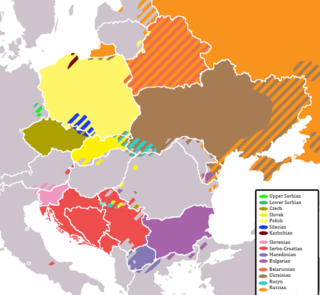
A pan-Slavic language is a zonal auxiliary language for communication among the Slavic peoples.

Dalmatian city-states were the Dalmatian localities where the local Romance population survived the Barbarian invasions after the fall of the Western Roman Empire in the 400s CE. Eight little cities were created by those autochthonous inhabitants that maintained political links with the Eastern Roman Empire. The original names of these cities were Jadera, Spalatum, Crespa, Arba, Tragurium, Vecla, Ragusium, and Cattarum. The language and the laws were initially Latin, but after a few centuries, they developed their own Neo-Latin language, Dalmatico, which lasted until the 19th century. The cities were maritime centres with huge commerce, mainly with the Italian peninsula and with the growing Republic of Venice.
